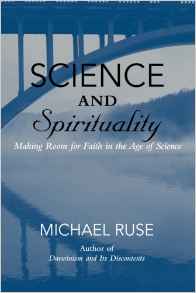 Science and Spirituality: Making Room for Faith in the Age of Science by Michael Ruse
Science and Spirituality: Making Room for Faith in the Age of Science by Michael Ruse
Reviewed by Oliver Robinson
Michael Ruse is a British philosopher and vocal proponent of science. He often debates proponents of intelligent design, leading the charge for Darwin. He is also believes that science has clear limits on what it can ever know, and that it leaves room for religious faith. His book Science and Spirituality: Making Room for Faith in the Age of Science sets out some arguments for this position. The choice of the term ‘spirituality’ in the title is a curious one, as the term is barely mentioned at all in the book (I couldn’t find a single instance). The book, we find out in the Introduction, is actually about science and Christianity, and whether it’s possible to be a scientist and a Christian. I sensed that the use of the word spirituality in the title may have been an editorial decision, to tap into a particular market even though the term is ill-suited to a book that focuses on one particular religion, and furthermore that doesn’t define spirituality or use the term. Yet the book is an interesting read despite the ill-suited title, particularly if you are interested in the hidden root metaphors that underpin science.
Of the eight chapters that comprise the book between introduction and conclusion, four explore the role of metaphor in science, and how the basic root metaphor for knowing the world around us has changed from world-as-organism in ancient Greece to world-as-machine in the modern era. In ancient Greece, both Plato and Aristotle saw the universe as animated by purpose and sentience, and saw all things being functional parts of an organismic whole, like the organs are functional parts of the physical body. Thus finding something’s purpose was central to understanding it. In the modern era, removing God from the world and conceiving of Him as pure transcendent spirit allowed the world to be seen as his artefact, which in turn led to the rise of the machine metaphor. The universe was God’s machine, created for his purpose using maths and rational design. To understand the universe was to understand its mechanical workings. Ruse traces the rise of the machine metaphor through physics into biology (e.g. Dawkins’ selfish gene ‘survival machines’), and then into the use of the computer metaphor in psychology to understand the mind.
Ruse concludes that because science rests on metaphor to make sense of the universe, it is fundamentally limited, because the root metaphors that science deploys are inappropriate for some questions and leave subjectivity all over what may appear to be objective descriptions. Metaphors are given by us, yet without them we are blind, as the world needs a frame of reference – but much of the world of science is invisible. No one has seen as electron. No one has seen gravity. We infer these by their effects, so their nature is alluded to metaphorically.
In Chapter 5, having reviewed the question of metaphors in science, Ruse goes on to explore the kinds of questions that mechanistic science cannot answer. These include: Why is there something rather than nothing? Why does anything exist at all? Why does maths describe the basic structuring of the universe? What is the right thing to do, morally speaking? Why are we conscious beings, not unconscious machines? What is the point of it all? The machine metaphor fails in these areas, because they require reasoning that is not causal and based on mechanisms.
In Chapter 6, Ruse briefly explores alternatives in science and philosophy to the mechanistic approach, in a chapter titled ‘Organicism’. Here he outlines how some scientists and philosophers have re-invigorated the Greek ‘world-as-organism’ metaphor by exploring how natural phenomena show examples of higher order, purpose and intelligence. He traces this through Romanticism, philosophers such as Spinoza and Schelling, then biologists such as Steven Jay Gould and Brian Goodwin, as well as holistic philosophies of Henri Bergson and Hans Driesch, and the physics of David Bohm, the emergentism of Stuart Kauffman and the Gaia hypothesis of Lovelock. All of these allude to a universe that is directional and intrinsically meaningful. Ruse moves over these ideas and thinkers with brevity, mainly to explore that there are other options available to the machine metaphor in the contemporary world. He studiously avoids the word spirituality in this chapter.
In Chapter 7, entitled ‘God’, Ruse starts with his review of Christian ideas and whether they fit with science. Ruse sets out his agenda for this chapter by explaining that Christianity deals with the questions that science struggles with, and uses non-scientific language and symbolism precisely because the questions themselves are non-scientific, and rightfully so. He runs us through the problem of evil, God’s omniscience, miracles, and human freedom, stating that all may elude science’s grasp so are acceptable Christian concerns. In Chapter 8, the survey of Christian concepts continues with morality, souls and life after death. Ruse reaches the conclusion that “in the light of modern science you can be a Christian”, because the core claims of religion are beyond science. However, he asserts that is only possible if you understand that ‘theological understanding is always on the move” and that much of Christianity needs revising.
A question that Ruse does not address is why, despite propounding that Christianity and science are complementary, he is not a Christian. Clearly he thinks it is problematic as a belief system, or else he would adopt it. He has left an elephant in the proverbial room: his own non-Christian spirituality. Why no mention of that?
